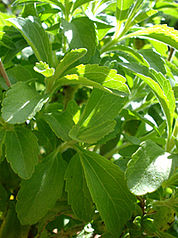Sweet and Healthy: Young consumers prefer the taste of Stevia ice-cream
By now, Stevia is being talked about as a natural sweetener, but not in the sense that it is “on everyone’s lips”. The food industry is still experimenting with this modern plant-based artificial sweetener on a wide variety of foodstuffs. The Belgian ESN member ROGIL investigated as to whether it functions as a sweetener in ice-cream.
 As of November 2011, the EU has approved the use of a glycoside (stevioside) from the Stevia rebaudiana (sweet leaf) plant as an sweetener in food. Not only is stevia a powerful sweetener – it also offers the possibility of making many food products more healthy. For the food industry, this sugar substitute is indeed interesting. However, as is also the case with synthetic sweeteners, whether it is in its natural form or as an isolated and purified stevioside, stevia does not have a one-to-one taste relationship with sugar. Stevioside has a licorice-like taste and often has a somewhat bitter after-taste. Its sweetening power is enormous. Depending on the method of extraction, stevioside can be 50 to 400 times as sweet as refined sugar.
As of November 2011, the EU has approved the use of a glycoside (stevioside) from the Stevia rebaudiana (sweet leaf) plant as an sweetener in food. Not only is stevia a powerful sweetener – it also offers the possibility of making many food products more healthy. For the food industry, this sugar substitute is indeed interesting. However, as is also the case with synthetic sweeteners, whether it is in its natural form or as an isolated and purified stevioside, stevia does not have a one-to-one taste relationship with sugar. Stevioside has a licorice-like taste and often has a somewhat bitter after-taste. Its sweetening power is enormous. Depending on the method of extraction, stevioside can be 50 to 400 times as sweet as refined sugar.
Impressive health benefits
When looking at the health benefits, the stevioside profile is impressive. Stevia does not cause tooth decay, does not put stress on the metabolism of diabetics, and is calorie-neutral. In addition, steviosides have a positive effect on high blood pressure, and because of infection-inhibiting ingredients, it has been shown to be helpful against such skin diseases as acne and eczema, as well as itching. In animal testing, stevioside inhibited the development of skin cancer.
Using 50 test subjects, the Belgian sensory company ROGIL, a European Sensory Network member, conducted a study as to whether steviosides from Stevia rebaudiana would be accepted as a sugar substitute in ice-cream. Approximately half of the subjects were younger men and women between the ages of 20 and 45, while the other half consisted of an older age group of between 46 to 65 years. In a blind taste test, the subjects sampled ice-cream with sugar and ice-cream with Stevia in varying sequences (different orders). They were told to indicate on a scale of 0-10 how good the particular product tasted.
Stevia well accepted as a sweetener for ice-cream
The test group found no significant difference between the two types of ice-cream. However, the Stevia ice-cream clearly appealed less to the older group (an average of 6.8 as compared to 7.8 points) in the overall rating. The older participants also rated the aftertaste of Stevia ice-cream as less enjoyable than the aftertaste of the ice-cream that was sweetened with sugar (6.5 versus 7.5 points).
Most of the test group found the sweetness of the ice-cream with sugar as “right on the mark”, while only 11 percent of the group found it too sweet. With the stevia variety, once again it was the older consumers for the most part who were bothered by the sweetness of the stevia variety. Approximately a third of this group found the stevia products “a bit too sweet”. Neither group found any difference between the after-taste of the two products.
When asked about preferences, (“which of the two products do you prefer?”), three quarters of the older group preferred the traditional ice-cream with sugar, whereas this was the choice of only 41 percent of the younger group. Instead, some 50 percent of the younger group preferred the stevia variety.
This variance influences the consumers’ readiness to buy a particular product. 76 percent of the older group would buy sugar-sweetened ice-cream, whereas only 52 percent of the older participants could conceive of buying Stevia ice-cream. With young consumers the difference was less defined: 68 percent would buy the “classic” style of ice-cream, whereas 59 percent would buy the Stevia product.
Acceptance related to experience with different types of sweeteners
ROGIL study leader Veerle Daems concluded from these results that especially the younger target groups, who have grown up with various alternative sweeteners, have the best chance of accepting stevia as sweetener in ice-cream. Older consumers who had grown up with only beet or raw sugar, admittedly prefer traditionally sweetened ice-cream at the present time. Nevertheless, many of them found that stevia ice-cream had a very good taste. Veerle Daems says that, “when consumers are informed of the health advantages of stevia, it becomes a real alternative to the traditional use of sugar.”
Contact:
Ludovic Depoortere, Veerle Daems
ROGIL
Romeinsestraat 4
3001 Leuven (Heverlee) - Belgium
Internet: www.haystack-international.com
Photo: Ina Schicker